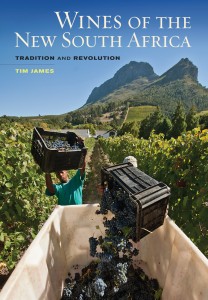Wines of the New South Africa, by Tim James
| Title of book: | Wines of the New South Africa – tradition and revolution |
| Author: | Tim James |
| Publisher: | University of California Press |
| Publication date: | 2013 |
| ISBN | 978-0-520-26023-8 |
| Pages: | 324 |
| Price: | £27.95 / US$39.95 |
 South Africa has long held the viticultural position of being ‘the old world in the new world’. In this book the author traces the roots of this new world country with the oldest of histories of winemaking, stretching back more than 350 years. And shows how that has informed the current status of the country’s industry.
South Africa has long held the viticultural position of being ‘the old world in the new world’. In this book the author traces the roots of this new world country with the oldest of histories of winemaking, stretching back more than 350 years. And shows how that has informed the current status of the country’s industry.
But it is the changes since 1994 that excite the country’s wine industry. The ‘new’ South Africa is defined as that existing since that date, the year of the country’s first democratic elections and a touchstone moment for the wine industry, as export markets began to open up in a post-apartheid era. This makes the South African industry very modern indeed. Its shape and constitution have changed dramatically in those less than 20 years, though not, interestingly its scale of production, especially given the increasing volumes of wine typically produced by other new world countries over recent time.
The rationale for such a recent date is emphasised by the release of restrictions earlier. It was as recently as 1992 that production quotas were abandoned. This meant that new regions could be planted. One such is Elim, though we also learn this wind-blown coastal region already had a few vineyards in the 1830s.
So while the vineyard size has not expanded dramatically since the early 1990s (about 5%), the vineyards have been a-moving, triffid-fashion, to new locales. This is one of the most exciting aspects of the new South Africa. Varietal composition of the vineyards is another, for example, syrah, now comprising 10% of the vineyard area, accounted for a negligible 1% of plantings in the early 1990s. Additionally, nascent observations show that certain cultivars do better in particular locations, including sauvignon blanc in Elim and Elgin, pinot noir in Heme-en-Aarde.
James leads the reader gently and informatively through all these, and other, dramatic – given the usual snail’s pace of viticultural development – changes.
He devotes a solid and information-packed chapter to the pre-1994 wine industry, one that stretches all the way to 1652. I’d never quite got my head round the KWV (an organisation set up in the early 20th century as a response to consistent overproduction). James sorts it. Thank you.
More than two-thirds of the book is devoted to reviewing producers, by region, beginning with a regional overview, and focusing on the plethora of private producers, many of whom have emerged in the new South Africa – together their numbers have grown from 170 in 1993 to over 500 in 2011, and they now account for shy of 20% of the country’s total production. The origins, personal stories and distinctive wines of these newer and longer-established producers are logged with admirable concision.
Topographical maps would have added an altitudinal and orientation aspect to vineyards and wineries. Some glossy pictures would have added a geographically dramatic element to what must surely be some of the world’s most jaw-droppingly beautiful vineyard regions. But such a book charting the modern blossoming of an historical region has been overdue. This book is welcome.



